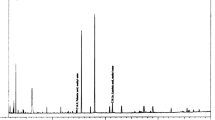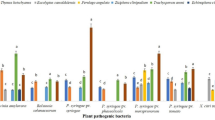Abstract
The essential oil from Callistemon viminalis (EOC) is rich in monoterpenes, with a variety of biological properties: antibacterial, antifungal, insecticide, and antioxidant. Inclusion complexes (ICs) with cyclodextrins (CDs) is an alternative to prevent toxicity, improve the activity, and reduce the concentration to be used. Thus, the objective of this work was to prepare an IC (EOC/β-CD) and evaluate the antibacterial, antifungal and phospholipase activities, as well as the toxicity. Antimicrobial activity used the agar diffusion test and antifungal activity the disc diffusion test. Toxicity tests were carried out using Lactuca sativa L. The inhibition of phospholipase activity using the venom of Bothrops atrox as an inducer was performed. Antibacterial and antifungal tests demonstrated a decrease in the minimum inhibitory concentration (MIC) of the IC. It was most significantly observed for the bacterium Listeria monocytogenes, for which there was a decrease in the MIC from 250 µg mL−1 to 62.5 µg mL−1 after complexation, and for the fungus Aspergillus flavus, with a decrease in MIC from 125 µg mL−1 to 62.5 µg mL−1 after complexation. Toxicity tests with Lactuca sativa showed a decrease in toxicity after complexation in all parameters analyzed, with no statistical difference from the negative control. Inhibition of phospholipase activity induced by Bothrops atrox venom was more expressive in the highest proportion studied (1:10 m:m), exerting 23% inhibition. The assays demonstrated that the complexation between the EOC and β-CD is a promising alternative for use in different branches, especially in food industry, to fully exploit its application potential.



Similar content being viewed by others
References
Rosa RCA, Ribeiro LR, Souza AMG, Fonseca TA (2016) Triagem Fitoquímica dos Extratos Aquosos de Bauhinia candicans, Foeniculum vulgare, Mentha pulegium e Morus nigra. Phytochemical screening of aqueous extracts of Bauhinia candicans, Foeniculum vulgare, Mentha pulegium and Morus nigra. Revista Conexão Ciência 11(1):44–51
Bors M, Sicińska P, Michałowicz J, Wieteska P, Gulewicz K, Bukowska B (2012) Evaluation of the effect of Uncaria tomentosa extracts on the size and shape of human erythrocytes (in vitro). Environ Toxicol Pharmacol 33(2):127–134. https://doi.org/10.1016/j.etap.2011.11.003
Benigni R (2005) Structure-activity relationship studies of chemical mutagens and carcinogens: mechanistic investigations and prediction approaches. Chem Rev 105(5):1767–1800. https://doi.org/10.1021/cr030049y
Venceslau AFA et al (2018) Cyclodextrins as effective tools to reduce the toxicity of atrazine. Energy Ecol Environ 3(2):81–86. https://doi.org/10.1007/s40974-017-0073-8
Sales TA et al (2017) Essential oils from the leaves and flowers of Callistemon viminalis: chemical characterization and evaluation of the insecticide and antifungal activities. Am J Plant Sci 08(10):2516–2529. https://doi.org/10.4236/ajps.2017.810171
Aguiar UN et al (2014) Preparação e caracterização do complexo de inclusão do óleo essencial de Croton zehntneri com β-ciclodextrina. Quím Nova 37(1):50–55. https://doi.org/10.1590/S0100-40422014000100010
Iacovino R et al (2016) Cyclodextrins as complexing agents: preparation and applications. Curr Org Chem 21(2):162–176. https://doi.org/10.2174/1385272820666160909111842
de Oliveira CM et al (2014) Chemical composition and allelopathic activity of the essential oil from Callistemon viminalis (Myrtaceae) Blossoms on Lettuce (Lactuca sativa L.) Seedlings. Am J Plant Sci 05(24):3551–3557. https://doi.org/10.4236/ajps.2014.524371
Badawy MEI, Abdelgaleil SAM (2014) Composition and antimicrobial activity of essential oils isolated from Egyptian plants against plant pathogenic bacteria and fungi. Ind Crops Prod 52:776–782. https://doi.org/10.1016/j.indcrop.2013.12.003
Fall R, Ngom S, Sall D, Sembène M, Samb A (2017) Chemical characterization of essential oil from the leaves of Callistemon viminalis (D.R.) and Melaleuca leucadendron (Linn.). Asian Pac J Trop Biomed 7(4):347–351. https://doi.org/10.1016/j.apjtb.2017.01.004
Caldas GFR et al (2016) Repeated-doses and reproductive toxicity studies of the monoterpene 1,8-cineole (eucalyptol) in Wistar rats. Food Chem Toxicol 97:297–306. https://doi.org/10.1016/j.fct.2016.09.020
Pires HC et al (2013) Composição química e atividade antimicrobiana dos óleos essenciais das folhas e flores de Callistemon viminalis (sol. ex Gaertn.) G. Don ex Loudon (Myrtaceae). Rev Ciências Farm Básica e Apl 34(4):597–601
Yadav R et al (2014) Differential larval toxicity and oviposition altering activity of some indigenous plant extracts against dengue and chikungunya vector Aedes albopictus. J Arthropod Borne Dis 8(2):174–185
Mello DR (2010) “Farmacopeia Brasileira,” Farm. Bras. 5a edição 2 1–523 [Online] Available: https://www.anvisa.gov.br
Martins LNSB (2018) Complexo de inclusão entre óleo essencial de Callistemon viminalis e β-ciclodextrina: preparação, caracterização, atividade antibacteriana, antifúngica e testes de toxicidade. PhD thesis, Universidade Federal de Lavras, Brasil
Menezes PP et al (2012) Solid-state β-cyclodextrin complexes containing geraniol. Thermochim Acta 548:45–50. https://doi.org/10.1016/j.tca.2012.08.023
Camargo KC et al (2017) Antimicrobial activity of the essential oil from Hyptis carpinifolia Benth. Am J Plant Sci 08(11):2871–2877. https://doi.org/10.4236/ajps.2017.811195
Clinical and Laboratory Standards Institute (CLSI) (2008) Reference method for broth dilution antifungal susceptibility testing of filamentous fungi, approved standard. CLSI document M38-A2, Pennsylvania
Andrade MA et al (2015) Biological activity of the essential oils from Cinnamodendron dinisii and Siparuna guianensis. Brazilian J Microbiol 46(1):189–194. https://doi.org/10.1590/S1517-838246120130683
Aragão FB et al (2015) Phytotoxic and cytotoxic effects of eucalyptus essential oil on lettuce (Lactuca sativa L.). Allelopath J 35(2):259–272
Gutiérrez J, Avila C, Rojas E, Cerdas L (1988) An alternative in vitro method for testing the potency of the polyvalent antivenom produced in Costa Rica. Toxicon 26(4):411–413. https://doi.org/10.1016/0041-0101(88)90010-4
Price MF, Wilkinson ID, Gentry LO (1982) Plate method for detection of phospholipase activity in Candida albicans. Sabouraudia 20(1):7–14. https://doi.org/10.1080/00362178285380031
Rangel M, Malpezzi ELA, Susini SMM, De Freitas J (1997) hemolytic activity in extracts of the diatom Nitzschia. Toxicon 35(2):305–309. https://doi.org/10.1016/S0041-0101(96)00148-1
Martins LNSB, Venceslau AFA, Carvalho LB, Jaime C, Cardoso MG, Pinto LMA (2020) Inclusion complex of Callistemon viminalis essential oil prepared by kneading. J Incl Phenom Macrocycl Chem 97:109–119. https://doi.org/10.1007/s10847-020-00989-w
Salem MZM, Ali HM, El-Shanhorey NA, Abdel-Megeed A (2013) Evaluation of extracts and essential oil from Callistemon viminalis leaves: antibacterial and antioxidant activities, total phenolic and flavonoid contents. Asian Pac J Trop Med. https://doi.org/10.1016/S1995-7645(13)60139-X
Hanci V, Vural A, Hanci SY, Ali Kiraz H, Ömür D, Ünver A (2014) In vitro evaluation of antimicrobial features of sugammadex. Brazilian J Anesthesiol Engl Ed 64(2):105–108. https://doi.org/10.1016/j.bjane.2013.09.003
Rakmai J, Cheirsilp B, Mejuto JC, Simal-Gándara J, Torrado-Agrasar A (2018) Antioxidant and antimicrobial properties of encapsulated guava leaf oil in hydroxypropyl-beta-cyclodextrin. Ind Crops Prod 111:219–225. https://doi.org/10.1016/j.indcrop.2017.10.027
Antunes MD et al (2017) Antimicrobial electrospun ultrafine fibers from zein containing eucalyptus essential oil/cyclodextrin inclusion complex. Int J Biol Macromol 104:874–882. https://doi.org/10.1016/j.ijbiomac.2017.06.095
Santos EH, Kamimura JA, Hill LE, Gomes CL (2015) Characterization of carvacrol beta-cyclodextrin inclusion complexes as delivery systems for antibacterial and antioxidant applications. LWT - Food Sci Technol 60(1):583–592. https://doi.org/10.1016/j.lwt.2014.08.046
Gong L et al (2016) An inclusion complex of eugenol into β-cyclodextrin: preparation, and physicochemical and antifungal characterization. Food Chem 196:324–330. https://doi.org/10.1016/j.foodchem.2015.09.052
Munhuweyi K, Caleb OJ, van Reenen AJ, Opara UL (2018) Physical and antifungal properties of β-cyclodextrin microcapsules and nanofibre films containing cinnamon and oregano essential oils. LWT 87:413–422. https://doi.org/10.1016/J.LWT.2017.09.012
Kfoury M et al (2016) Solubility, photostability and antifungal activity of phenylpropanoids encapsulated in cyclodextrins. Food Chem 196:518–525. https://doi.org/10.1016/j.foodchem.2015.09.078
Calo JR, Crandall PG, O’Bryan CA, Ricke SC (2015) Essential oils as antimicrobials in food systems-a review. Food Control 54:111–119. https://doi.org/10.1016/j.foodcont.2014.12.040
Hąc-Wydro K, Szydło K (2016) The influence of environmentally friendly pesticide–Eucalyptol-alone and in combination with terpinen-4-ol—on model bacterial membranes. Colloids Surf B 146:918–923. https://doi.org/10.1016/j.colsurfb.2016.07.044
Bali AS, Batish DR, Singh HP, Kaur S, Kohli RK (2017) Phytotoxicity and weed management potential of leaf extracts of Callistemon viminalis against the weeds of rice. Acta Physiol Plant 39(1):1–9. https://doi.org/10.1007/s11738-016-2313-5
Rezende DACS et al (2017) Essential Oils from Mentha piperita, Cymbopogon citratus, Rosmarinus officinalis, Peumus boldus and Foeniculum vulgare: inhibition of phospholipase A2 and cytotoxicity to human erythrocytes. Am J Plant Sci 08(09):2196–2207. https://doi.org/10.4236/ajps.2017.89147
Nirmal N, Om Praba G, Velmurugan D (2008) Modeling studies on phospholipase A2-inhibitor complexes. Indian J Biochem Biophys 45(4):256
Acknowledgements
The authors thank the Coordenação de Aperfeiçoamento de Pessoal de Nível Superior (CAPES), Fundação de Amparo à Pesquisa do Estado de Minas Gerais (FAPEMIG), Conselho Nacional de Desenvolvimento Científico e Tecnológico (CNPq), Centro de Análise e Prospecção Química (CAPQ), the Laboratório de Produtos Naturais e Sintéticos, the Laboratório de Micotoxinas e Micologia de Alimentos of the Departamento de Ciência dos Alimentos and the Universidade Federal de Lavras for their financial support for the execution of this research. We also acknowledge Dr. D. L. Nelson for the English review of the paper.
Author information
Authors and Affiliations
Contributions
LNSBM: Conceptualization, Methodology, Validation, Investigation, Writing—original draft, Writing—review & editing. AFAV: Methodology, Investigation, Formal analysis. RMB: Methodology, Investigation, Formal analysis. MAB: Methodology, Investigation, Formal analysis. LRB: Conceptualization, Resources, Formal analysis. MGC: Resources, Methodology. LMAP: Conceptualization, Resources, Writing—original draft, Writing—review & editing, Supervision.
Corresponding author
Ethics declarations
Conflict of interest
The authors declare no conflicts of interest, and that they all agree with the submission of the manuscript.
Additional information
Publisher's Note
Springer Nature remains neutral with regard to jurisdictional claims in published maps and institutional affiliations.
Rights and permissions
About this article
Cite this article
Martins, L.N.S.B., Venceslau, A.F.A., Brandão, R.M. et al. Antibacterial and Antifungal Activities and Toxicity of the Essential Oil from Callistemon viminalis Complexed with β-Cyclodextrin. Curr Microbiol 78, 2251–2258 (2021). https://doi.org/10.1007/s00284-021-02480-2
Received:
Accepted:
Published:
Issue Date:
DOI: https://doi.org/10.1007/s00284-021-02480-2




